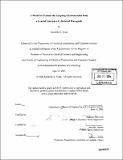A model to evaluate the coupling characteristics from a coaxial line into a cylindrical waveguide
Author(s)
Youn, Michelle S. (Michelle Soyeoun), 1979-
DownloadFull printable version (6.051Mb)
Other Contributors
Massachusetts Institute of Technology. Dept. of Electrical Engineering and Computer Science.
Advisor
Anthony Petrovich and David H. Staelin.
Terms of use
Metadata
Show full item recordAbstract
The current method of evaluating the coupling characteristics for a resonant microwave cavity sensor, such as that for the Flexured Mass Accelerometer, is limited to finite-element analysis, which takes approximately five to six days for one coupler configuration. The solution presented in this paper is based on segmenting the larger problem into smaller models, in order to improve design efficiency and optimization. The "segment" analyzed in this paper is the coupling characteristic from a coaxial line to a specific TE or TM mode of a cylindrical waveguide. The derived expressions allow for an efficient way of approximating the amount of power projected onto a TE or TM mode for any coupler loop configuration. The model was verified by confirming that the total power radiated into the waveguide was approximately equivalent to the sum of the powers in the propagating modes of the waveguide. The error associated with this method ranged from five to seventeen percent. It was further verified that the coupling intensities were greatly dependent on the relationship between the orientation of the loop and the magnetic field pattern for a specific waveguide mode. An area for further development may be to extend this method of analysis to incorporate the entire two-port cavity structure. Also, the losses associated with the non-idealities in the cavity structure may be evaluated. The development of these two areas would provide the means for calculating the coupling characteristic for the resonant cavity.
Description
Thesis (M. Eng.)--Massachusetts Institute of Technology, Dept. of Electrical Engineering and Computer Science, 2001. Includes bibliographical references (p. 73).
Date issued
2001Department
Massachusetts Institute of Technology. Department of Electrical Engineering and Computer SciencePublisher
Massachusetts Institute of Technology
Keywords
Electrical Engineering and Computer Science.